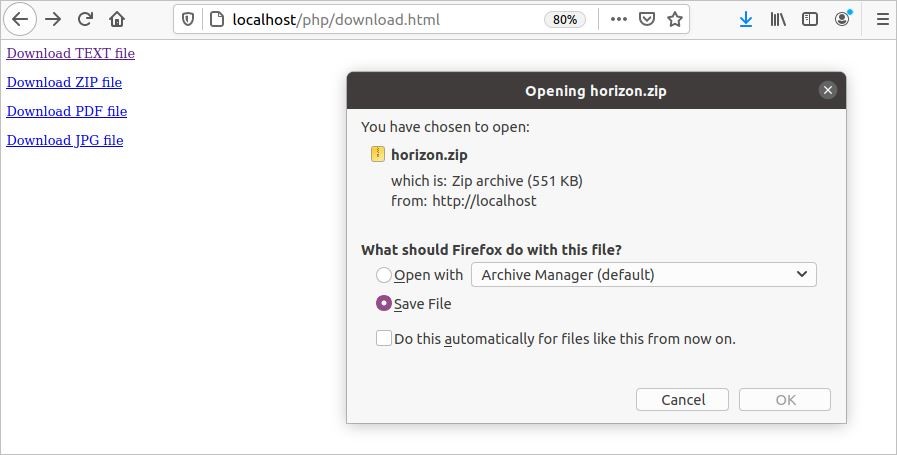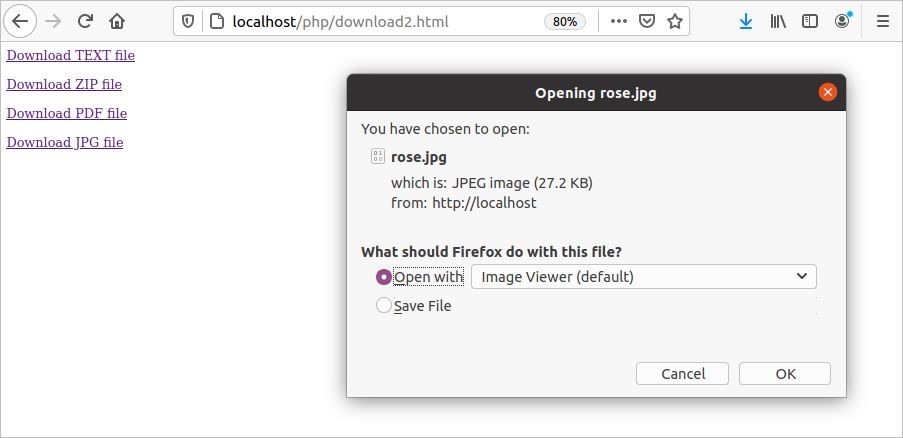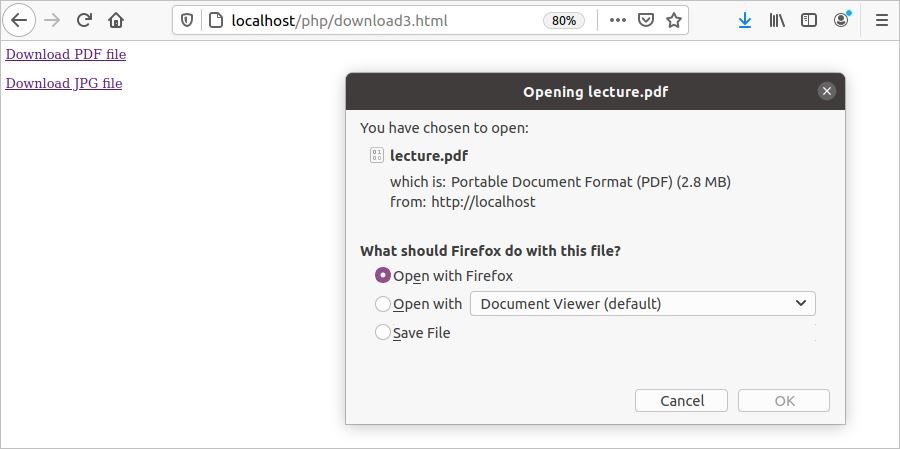Check Download Links
It was previously mentioned that zip and exe files download automatically, without using PHP script. First, create an HTML file with the following code. Here, the four anchor elements are defined to download the four types of files. These file types include TEXT, ZIP, PDF, and JPG files.
Download.html
Output
The following dialog box will appear to download the file after clicking the zip file link. The user can then download the file or open the file in the archive manager.
If you click on the image file, the image will be opened automatically in the browser, as shown in the following output. You must save the file to make a copy of the image file in the local drive. In the same way, when you click on PDF and TEXT file links, the content of the file will be opened in the browser without downloading the file. The solution to this problem is to download the file forcibly using the built-in PHP readfile() function.
Download File Using readfile() Function
The readfile() function is used in PHP script to forcibly download any file of the current location, or the file with the file path. The syntax of this function is given below.
Syntax
int readfile ( string $filename [, bool $use_include_path = false [, resource $context ]] )
This function can take three arguments. The first argument is mandatory, and the other two arguments are optional. The first argument, $filename, stores the filename or filename with the path that will download. The default value of the second parameter, $use_include_path, is false and will be set to true if the filename with the path is used in the first argument. The third argument, $context, is used to indicate the context stream resource. This function returns the number of bytes read from the file mentioned in the first argument. The uses of this function are shown in the following two examples.
Example 1: Download File with Filename
In this example, we will create an HTML file with the following code, where the file name will be passed as a parameter of the URL named path, and the value of this parameter will be passed to the PHP file named download.php.
download2.html
<head>
<title>Download Files</title>
</head>
<body>
<p><a href="download.php?path=abc.txt">Download TEXT file</a></p>
<p><a href="download.php?path=horizon.zip">Download ZIP file</a></p>
<p><a href="download.php?path=lecture.pdf">Download PDF file</a></p>
<p><a href="download.php?path=rose.jpg">Download JPG file</a></p>
</body>
</html>
We will create the PHP file with the following code to download the file forcibly. Here, the isset() function is used to check whether the $_GET[‘path’] is defined. If the variable is defined, the file_exists() function is used to check whether the file exists in the server. Next, the header() function is used to set the necessary header information before using the readfile() function. The basename() function is used to retrieve the filename, and the filesize() function is used to read the size of the file in bytes, which will be shown in the opening dialog box to download the file. The flush() function is used to clear the output buffer. The readfile() function is used with the filename only, here.
download.php
if(isset($_GET['path']))
{
//Read the filename
$filename = $_GET['path'];
//Check the file exists or not
if(file_exists($filename)) {
//Define header information
header('Content-Description: File Transfer');
header('Content-Type: application/octet-stream');
header("Cache-Control: no-cache, must-revalidate");
header("Expires: 0");
header('Content-Disposition: attachment; filename="'.basename($filename).'"');
header('Content-Length: ' . filesize($filename));
header('Pragma: public');
//Clear system output buffer
flush();
//Read the size of the file
readfile($filename);
//Terminate from the script
die();
}
else{
echo "File does not exist.";
}
}
else
echo "Filename is not defined."
?>
Output
The following output will appear after clicking the download link of the image file. The file size of the rose.jpg image is 27.2 KB, as shown in the dialog box. You can download the file by selecting the Save File radio button and pressing the OK button.
Example 2: Download File with File Path
If the file exists at the given file location, the file path will be required to mention in the URL. In this example, we will create an HTML file with the following code, which will pass the filename with the file path:
download3.html
We will create a PHP file with the following code to download a file from the file path. The PHP code in the previous example will be slightly modified to download the file from the given path. The clearstatecache() function is used to clear the cache that was previously stored. Two arguments are used in the readfile() function.
download2.php
if(isset($_GET['path']))
{
//Read the url
$url = $_GET['path'];
//Clear the cache
clearstatcache();
//Check the file path exists or not
if(file_exists($url)) {
//Define header information
header('Content-Description: File Transfer');
header('Content-Type: application/octet-stream');
header('Content-Disposition: attachment; filename="'.basename($url).'"');
header('Content-Length: ' . filesize($url));
header('Pragma: public');
//Clear system output buffer
flush();
//Read the size of the file
readfile($url,true);
//Terminate from the script
die();
}
else{
echo "File path does not exist.";
}
}
echo "File path is not defined."
?>
Output
After the download link of the PDF file is clicked, the following output will appear.
Video Tutorial
Conclusion
This article provided a simple way to forcibly download any file using the PHP script, to help readers to add the download feature in their script.




